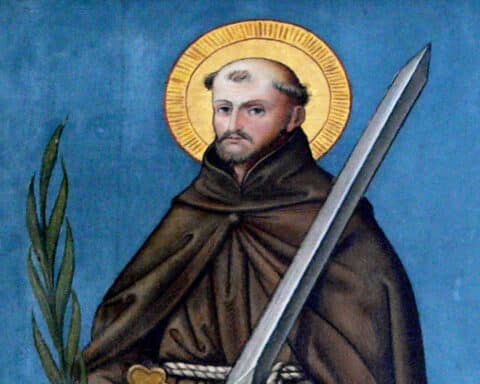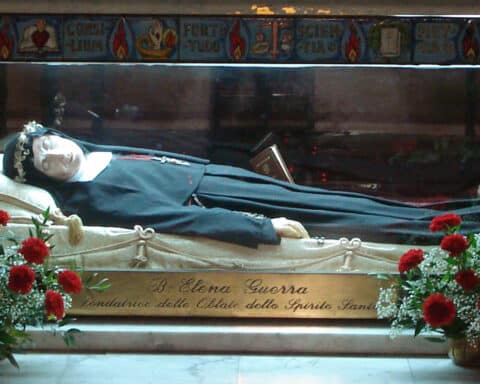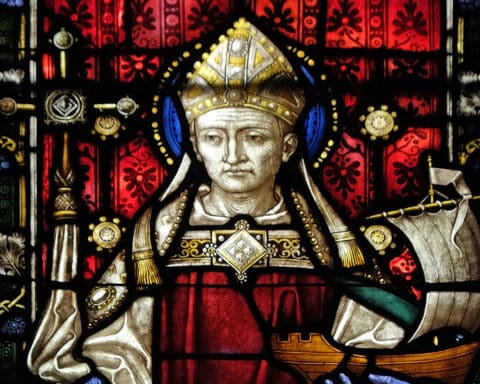Fondly called the “Apostle of Ireland,” St. Patrick is a model evangelist for us today. Born in A.D. 387 in Roman Britain, he was enslaved in Northern Ireland after being kidnapped by Irish pirates. He was about 16 at the time. For six years he tended the flocks of a pagan chieftain while praying intensely. Although this was a trying time for St. Patrick, it presented him with invaluable training in fortitude and an awareness of the language and culture of the Irish people he would later spend his life bringing to the Christian faith.
Following the advice of an angel, young St. Patrick escaped his captors and walked approximately 200 miles to the coast of Ireland, where he was able to convince a group of sailors to take him back to Britain. But he didn’t stay away from Ireland long. In the best known passage of his “Confession,” (a simple, beautiful autobiographical profession of faith) St. Patrick describes reading a letter titled, “The Voice of the Irish People.” St. Patrick recalls, “They called out as it were with one voice: ‘We beg you, holy boy, to come and walk again among us.'”
Persecuted in Ireland
Upon arriving back in Ireland, St. Patrick first paid the price of ransom to his former master, and in exchange for the enslavement and cruelty he had endured, instead imparted his blessings to his former master. Although working peacefully among the druids, St. Patrick’s apostolate in Ireland was not a series of tranquil victories. In his “Confession,” St. Patrick explains that he and his companions were seized and carried off as captives no fewer than 12 times! On one occasion in particular he was put in chains and sentenced to death.
St. Patrick went through the countryside of Ireland with his retinue, braving storms, hunger and countless other hardships. Despite all the challenges he faced, all the while he turned hearts to Christ. He passionately describes his ministry saying to the Irish people, saying: “I spend myself for you, so that you may have me for yours. I have travelled everywhere among you for your own sake, in many dangers, and even to the furthest parts where nobody lived beyond, and where nobody ever went to baptise and to ordain clerics or to bring people to fulfilment. It is only by God’s gift that I diligently and most willingly did all of this for your good.”
Building the Irish church
His helpers built hundreds of churches, while he personally ordained many priests and baptized thousands of souls. He traveled with a large group of people to comprised of priests, and common lay people to include farmers, cooks, and musicians, all ready to convert a nation. Wherever they pitched camp, there a parish would be established through baptisms before they took to the road again. St. Patrick’s gradual, deliberate means of conversion Christianized the whole of Ireland within two hundred years of the start of his ministry making Ireland the only country in Europe to be converted to Christ peacefully. His efforts brought an end in Ireland to pagan practices, including terrible evils like slavery, human sacrifice and intertribal warfare.
Towards the end of his life, St. Patrick often withdrew into the mountains–now known as Croagh Patrick–to talk to God. Here he had to deal not only with storms and wind, but also with the temptations of demonic powers, while he did penance for the Irish people. In A.D. 493, St. Patrick was called home to God. St. Tassach gave him his last sacraments, and his body was wrapped in a shroud woven by St. Brigid.
Reflection
Dear Jesus, I pray to fall in love with you so much so that I am unafraid to share the power of your love with an alien culture. May I take the time to talk to you and pray unceasingly throughout the day so that all people I encounter may only see you in all that I do.
Prayer
O God, who chose the Bishop Saint Patrick
to preach your glory to the peoples of Ireland,
grant, through his merits and intercession,
that those who glory in the name of Christian
may never cease to proclaim your wondrous deeds to all.
Through our Lord Jesus Christ, your Son,
who lives and reigns with you in the unity of the Holy Spirit,
God, for ever and ever.





